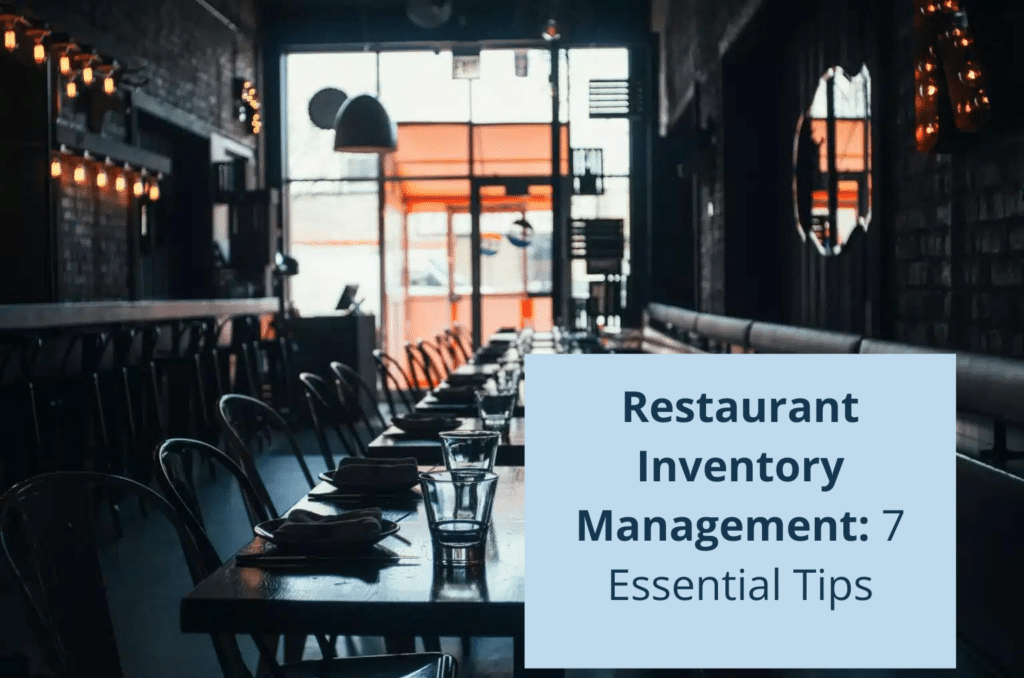Updated on: April 15, 2024
When it comes to running a restaurant, there are so many things you’d rather be doing than managing inventory. Filling out inventory sheets and food waste sheets, crunching daily sales numbers, tweaking menu prices, calculating sell-through rates and inventory costs down to the basic unit of measure or every individual ingredient in every dish…gah!
We understand—determining the best inventory methods is not why you got into this business. You’re here to make good food and keep customers happy. That said, we also understand how crucial it is to keep close, accurate track of inventory. Dull as it may be, it is key to the success of your establishment. That’s where we come in to help make this task a little bit easier for you.
Proper inventory management is essential for any restaurant. It ensures that you have the right amount of stock on hand, so you never run out of ingredients or products. It also helps you minimize waste and track your costs more effectively. With the right systems in place, you can streamline your operations and ultimately increase your profitability.
Having a solid inventory management system in place can significantly impact your bottom line. It can help you save time, reduce costs, and improve overall efficiency. If you’re feeling overwhelmed by the task of managing your restaurant’s inventory, you are not alone! We’ve helped many restaurants maximize their cost savings from good inventory management and we can help you too.
Our inventory management solutions are designed to simplify the process and help you run your restaurant more effectively. Let us take this off your plate so you can focus on the aspects of your business that you truly enjoy.
What is restaurant inventory management?
Restaurant inventory management refers to the process of tracking and controlling all the food, beverages, and supplies that a restaurant has on hand. It is vital for both long-term strategic decisions and day-to-day business decisions.
This includes everything from food supplies in the kitchen and other kitchen supplies, to napkins and cleaning supplies. Effective inventory management is crucial for a restaurant’s success, as it helps to prevent food waste, control costs, and ensure that menu items are consistently available to customers.
According to the National Restaurant Association, food and beverage costs account for about 33 cents of every dollar in sales. With margins in the food and beverage industry being as tight as they are, this means that even small savings in inventory (especially edible ingredients which are fairly quick to spoil) can add up quickly. This makes it essential for restaurants to have a solid inventory management system in place to avoid overstocking or running out of critical items.
By keeping an accurate count of inventory levels and closely monitoring usage and ordering patterns, restaurants can minimize waste and optimize their purchasing decisions. This not only helps to improve profitability but also ensures that customers have a great dining experience. Additionally, advanced inventory management systems can help streamline processes, automate reordering, and provide valuable insights into product performance.
To make a tired point, restaurant inventory management is an integral part of running a successful and profitable establishment. By staying on top of inventory levels and implementing efficient management practices, restaurants can reduce costs, minimize waste, and ultimately provide better service to their customers.
Why should I care about inventory management?
If you’re in the restaurant industry, you know just how alarmingly tight the margins can be. Every dollar counts, and waste and inefficiency can really eat into your bottom line. That’s why inventory management is so crucial for any restaurant.
According to a study by the National Restaurant Association, commercial kitchens waste anywhere from 4% to 10% of the food that they purchase. This is a staggering figure, it’s money effectively rotting away and it highlights just how much of an impact waste and inefficiency can have on a restaurant’s profitability and how important inventory control is.
Effective inventory management can help you reduce waste, cut costs, and improve your overall efficiency. By keeping careful track of your inventory levels, you can avoid over-ordering and ensure that you’re using up ingredients before they spoil. This can lead to significant savings over time and help you maintain healthier profit margins.
In addition, accurate inventory management can also help you identify trends in your sales and make more informed purchasing decisions. This can help you optimize your menu and ensure that you’re always offering your customers what they want, when they want it.
In short, inventory management may not be the most glamorous aspect of running a restaurant, but it can have a huge impact on your bottom line. So if you care about maximizing your profits and minimizing waste, it’s definitely something worth paying attention to.
Where do I start with inventory management?
So, you’ve realized the importance of restaurant inventory management and you’re ready to take control of your stock. We understand that it can be overwhelming, but we’re here to help! Here are 7 tools steps to get you started on the right track. We’ll talk a bit more about each one, but here’s a brief summary.
First and foremost, hire good people. Having a staff that you know you can count on to do their work and do it well will give you peace of mind and make your restaurant run more efficiently. This is especially true with the inventory process.
Next, do an inventory count. It’s important to know exactly what you have on hand. Conduct a thorough inventory count to get a clear picture of your stock levels.
Now keep doing that second step. Count your physical inventory on a regular basis. It may help to have a marked “Inventory Day” on the calendar every month. Improper inventory management can incur significant costs and always having a good idea of what you have is vital for any inventory solution.
Collect and analyze sales data. This can help with literally every aspect of your restaurant but is especially useful for inventory forecasting.
First-in, first out. What comes into your inventory first, goes out first is a popular adoption method. This is especially important for fresh ingredients that can spoil in days or even hours.
Revisit the menu from time to time. Analyze historical patterns to determine which items sell best and which don’t and tweak your menu accordingly.
Lastly, build your system on a good, reliable and user-friendly restaurant inventory management software platform. This is our specialty and we can demonstrate how our software suite can be tailored to your specific needs.
Remember, every restaurant is unique, so these steps may need to be adjusted to fit your specific needs. It’s not a precise science, but we’ve distilled the 7 most essential points for effective restaurant inventory management:
- Train staff you can trust
- Precision inventory counts
- Never stop repeating point 2…
- Capture data and analyze historical sales (with our suite of applications, this isn’t as complicated as it may sound)
- Implement a first in, first out (FIFO) system – or appropriate system for your brand
- Tweak the menu from time to time
- Use specialized software
But by focusing on these essentials, you’ll have a solid foundation for effective inventory management.
Hire and train staff that you can trust
Hiring and training trustworthy and competent staff members is crucial for the success of any restaurant. Not only do they represent your brand, but they also play a key role in providing exceptional customer service, leading to customer satisfaction and repeat business.
Good staff members can add immense value to a restaurant by creating a positive and welcoming environment for guests. They can build rapport with customers, ensuring they have an enjoyable dining experience, and ultimately increasing the likelihood of positive online reviews and word-of-mouth referrals.
Additionally, trustworthy staff play a critical role in inventory management. They are responsible for ensuring that proper procedures are followed to minimize waste, theft, and spoilage.
It’s your kitchen staff who are going to be opening up pantries and refrigerators several times a shift and seeing what’s there. Many of them will develop an innate sense of the daily consumption rates of various food items and training them to help you with inventory management means you’ll have many eyes and hands contributing to the task.
Also, if you really hate doing inventory counts yourself, you can entrust this process to a reliable employee to do it for you, freeing up your time for other things.
Ultimately, hiring and training staff that you can trust is essential for the success and profitability of your restaurant. They are the face of your business and have a direct impact on customer satisfaction and retention. Additionally, it’s their care and vigilance that can help reduce waste through spoilage or overstocking.
Taking the time to invest in finding and developing a reliable team will pay off in the long run, leading to a strong and successful restaurant business.
Carry out precise inventory counts
Yes, you need to literally count all of your inventory items.
We know, we know! Physical counts are boring and tedious. We never said the inventory management process is the most exciting topic to discuss, but trust us when we say that it is absolutely essential.
You need to have accurate, current counts of all items in stock. Having precise inventory counts is crucial for any business, but especially for those in the restaurant industry.
Why, you ask?
Well, knowing exactly how much product is in your inventory allows you to have better control over your costs and ordering. It helps in preventing overstocking which can lead to wastage, and understocking which can lead to unhappy customers and lost sales.
So, as much as counting every single item in your inventory may seem like a tedious and time-consuming task, it is absolutely worth it in the long run. And the good news is, there are plenty of modern tools and technology available to help make this process much easier and less time-consuming.
If you’re looking for a more efficient way to manage your inventory counts, we have just the solution for you. Reach out to us today to learn more about our inventory management services and how we can help your business save time and money. Trust us, it’s worth it!
Track inventory consistently
You’ve counted your inventory once, now do it again. And again. And again.
We know it was boring the first time. Unfortunately, it’s not any more exciting the second, third or umpteenth time but regular inventory counts are what enable you to have a firm grasp on what you have in stock and how quickly you use it.
In order to keep overhead costs and waste to a minimum, you need accurate stock levels. Not having it can lead to over or understocking, which can impact your bottom line.
By effectively tracking your inventory, you can optimize your ordering process, maintain ideal stock levels, reduce stockouts, minimize waste and ultimately increase your sales.
It can be very tempting to let this slide but we implore you: don’t do it! Poor inventory tracking can hold your business back or even sink it entirely. We know inventory and purchasing can be tedious but we can help with both!
Forecast demand by analyzing historical sales
Forecasting demand is a crucial aspect of inventory management for any restaurant.
By capturing and analyzing historical sales data, restaurant owners and managers can gain valuable insights into customer behavior, seasonal trends, and popular menu items. This information allows them to make more accurate predictions about future demand and adjust their inventory levels accordingly.
Analyzing historical sales data can help restaurants identify patterns and recurring trends, such as peak hours or days of the week when certain items are in high demand. This knowledge enables them to optimize their inventory levels, ensuring that they have enough stock on hand to meet customer demand without overstocking and risking wastage.
Furthermore, by forecasting demand based on historical sales data, restaurants can make informed purchasing decisions, avoiding stock outs of popular items or excess inventory of slow-moving products. This not only helps to reduce food waste but also improves cash flow and overall profitability.
In a competitive industry like the restaurant business, accurate demand forecasting can give establishments a significant edge. It allows them to streamline their operations, minimize waste, and provide better customer service by consistently having the items customers want available.
Capturing and analyzing historical sales data is a powerful tool for improving inventory management in the restaurant industry. Indeed, sophisticated data capture and analytics is one of the most revolutionary things to hit the food and beverage industry in years.
We can help you capture and leverage this information so your restaurant can make more informed decisions about purchasing, reduce waste, and ultimately, improve their bottom line.
Adopt the first-in, first-out (FIFO) method
Are you struggling with managing your restaurant inventory? Have you heard of the first-in, first-out (FIFO) method?
The FIFO method is a way of organizing and managing inventory by ensuring that the oldest products are used or sold first. This means that the items that were first added to your inventory are also the first to be used or sold.
In the restaurant industry, FIFO is especially crucial for several reasons.
Firstly, it helps to prevent food waste by ensuring that perishable items are used before they expire. This can ultimately save your business money and reduce unnecessary waste. Additionally, using the FIFO method can help to maintain the quality and freshness of your ingredients, resulting in higher customer satisfaction and repeat business.
Overall, adopting the FIFO method in your restaurant inventory management can lead to improved cost-efficiency, reduced waste, and better quality control. If you’re looking to streamline your operations and improve your bottom line, implementing FIFO could be the solution you’ve been searching for.
Revisit the menu from time to time
You’ve probably put a lot of time and consideration into every item on your menu. Would it be an exaggeration to say that all of the dishes on your menu are like children to you? Maybe, but if it’s there you probably put it there for a reason.
That said, it’s important to remember that every restaurant is going to have especially popular items on their menu and other items that don’t sell as well.
That’s why it’s a good idea to revisit your menu from time to time to identify those unpopular items and consider if you want them to stay on there.
Consumer demand and preferences change. Removing unpopular menu items can actually have some great benefits for your business.
First of all, it can improve your inventory management. By focusing on the items that are actually selling, you can reduce the amount of inventory you need to keep on hand, which can save you money in the long run.
Not only that, but it can also help reduce waste and spoilage. When you have a lot of items on your menu that aren’t selling, you run the risk of having ingredients go bad before you can use them all. By streamlining your menu to focus on the items that are actually selling, you can reduce the amount of waste you have to deal with.
So, take some time to revisit your menu and see if there are any items that just aren’t cutting it. It could end up being a great move for your business in the long run!
Use Specialized Software
Are you feeling overwhelmed by the daunting task of restaurant inventory management? Don’t worry, you’re not alone. Many restaurant owners and managers struggle to keep track of their inventory, leading to inefficiencies, waste, and lost profits. But the good news is that there are software tools out there to help make this process much easier.
SynergySuite suite of applications, a comprehensive restaurant management software package that takes the guesswork out of inventory management.
With our award-winning software you can streamline your restaurant operations. You can easily track and monitor your inventory in real-time, allowing you to see exactly what you have on hand, what needs to be ordered, and what items are moving quickly or sitting on the shelf. This real-time visibility enables you to make informed decisions about purchasing, reducing waste, and optimizing your menu offerings.
In addition to real-time tracking, SynergySuite also offers features like barcode scanning, automatic inventory alerts, and customizable reporting, making inventory management fast, easy, and accurate. And with cloud-based access and easy to use mobile applications, you can keep an eye on your inventory from anywhere, at any time.
So if you’re tired of the headaches and hassles of manual inventory management, let us help you make it as easy as it can be. Get in touch with us today. We can schedule a demo that will enable us to demonstrate how our suite of applications can provide customized solutions to your operations.
Say goodbye to inventory-related stress and hello to increased efficiency, reduced waste, and improved profits. With the right tools in place, you can take control of your restaurant’s inventory and set your business up for long-term success.
Frequently asked questions about restaurant inventory management
Running a restaurant can be a busy and challenging endeavor, and one of the key aspects to keep in mind is efficient inventory management. Here are five common questions about restaurant inventory management:
What is restaurant inventory management?
Restaurant inventory management involves tracking and controlling the ingredients and supplies that a restaurant uses to create its dishes and maintain its operations.
Why is inventory management important for a restaurant?
Effective inventory management helps to reduce waste, control costs, and ensure that a restaurant has the necessary supplies to meet customer demands.
How often should restaurant inventory be counted?
Many restaurants choose to count their inventory on a weekly or monthly basis to ensure accurate tracking and ordering of supplies.
What are the benefits of using inventory management software?
Inventory management software can help streamline the process, provide real-time data on inventory levels, automate reordering, and reduce human error.
How can a restaurant improve its inventory management?
Implementing a first-in, first-out (FIFO) system, conducting regular audits, training staff on proper storage and handling of supplies, and utilizing technology can all help improve inventory management.
In a competitive industry like restaurants, efficient inventory management can make a big difference in the bottom line. If you’re looking for ways to streamline your restaurant’s inventory management, we’d be happy to help. Our solutions are designed to simplify the process and save you time and money. Let’s chat and see how we can work together to optimize your inventory management.






